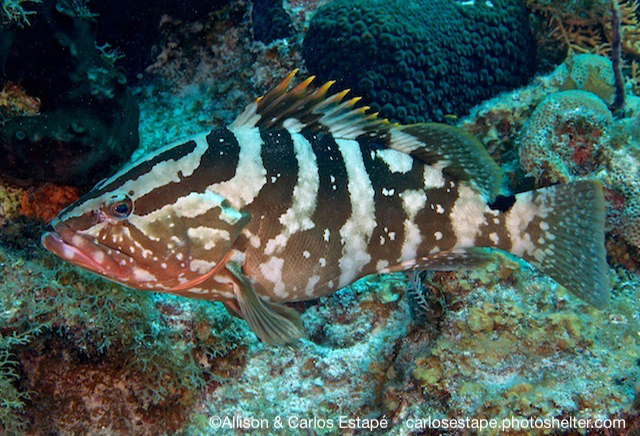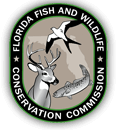Nassau Grouper
| Life History Parameters | Value |
|---|---|
| Maximum weight (kg) | 27 |
| Maximum age (year) | 29 |
| Age at length 0 (year) | -1.12 |
| Age at Maturity (months) | 60 |
| Maximum Length (cm) | 100 |
| Length at Maturity (cm) | 40 |
| Linf. Asymptotic Length (cm) | 76.0 |
| K - von Bertalanffy growth coefficient | 0.13 |
| Natural Mortality | 0.18 |
| Jan | Feb | - | - | - | - | - | - | - | - | - | Dec |
Habitat and Distribution
This species is associated with coral reefs (adults) and seagrass beds (juveniles) in the western Atlantic from northern Florida and Bermuda to Guyana, including the Gulf of Mexico and throughout the Caribbean.
Spawning season in the Gulf of Mexico
The estimated spawning season for the GOM is December to February based on information from Cuba and the Florida Keys.
Spawning Patterns
Nassau Grouper migrate long distances (up to several hundred kms) to form large, transient spawning aggregations of hundreds to tens of thousands of individuals at specific locations. The aggregations form adjacent to reef promontories over a 7 to 10 day period in relation to the full moon, with peak spawning occurring during a 2 to 4 day period. Spawning occurs in the evening near dusk, within sub groups of numerous males and a single female. Nassau Grouper are broadcast spawners with external fertilization.
Fishing Patterns in Relation to Spawning
The fishery is closed in federal waters and in most state waters of the U.S. Gulf of Mexico. Historically, commercial and recreational fishing activities for Nassau grouper were focused almost entirely on the spawning aggregations, and this interaction is thought to be the principal driver of the collapse of aggregation sites and fisheries for the Nassau grouper throughout much of its species range. However, interactions between fishing and spawning are no longer thought to be significant in the US due to the protected status of Nassau Grouper in US federal waters. In Mexico, many aggregation sites have declined or have been extirpated in recent decades, though recent efforts have resulted in the protection of several sites. Likewise, in Cuba, Nassau Grouper spawning aggregations were heavily targeted for decades and it is believed that most aggregations have declined or disappeared though there have not been recent assessments.
Management of Spawning Aggregations
There has been a complete ban on the fishing of Nassau Grouper in US federal waters since 1990, which includes the entire US Gulf of Mexico. Management for Nassau grouper in the southern Gulf of Mexico in Mexico has been sporadic, focused mainly on a fishery ban for all groupers from February 15 to March 15 that covers only part of the spawning season. A few spawning aggregations are thought to occur within natural protected areas,but none are thought to be closed or protected from fishing.
Research and Management Priorities
Reports of Nassau Grouper in the Gulf of Mexico are relatively rare and sporadic outside the Yucatan peninsula, and Cuba. Given the endangered status of the species, surveys on the timing, distribution, and abundance of fish at aggregation sites in these regions is critical for assessing the regional status of the species. This information is important for the US Gulf of Mexico, where no information exists on whether Nassau Grouper spawn in the region or the timing or locations of possible spawning.




